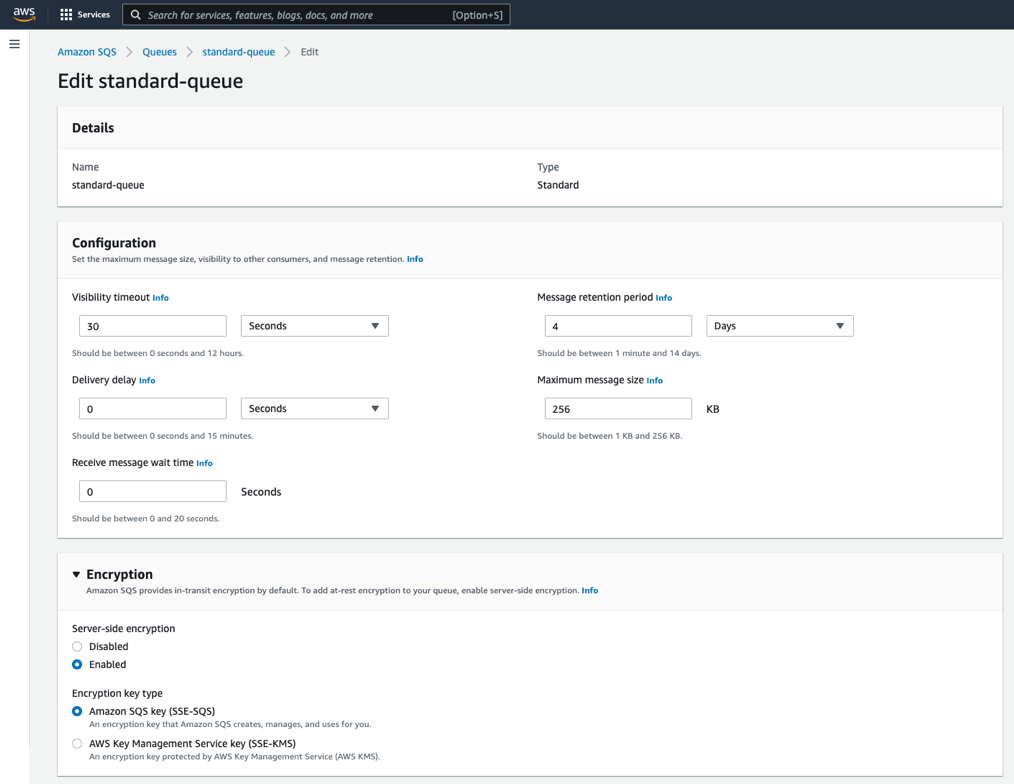AWS Compute Blog
Category: Amazon Simple Queue Service (SQS)
Implementing AWS Well-Architected best practices for Amazon SQS – Part 2
This blog is written by Chetan Makvana, Senior Solutions Architect and Hardik Vasa, Senior Solutions Architect. This is the second part of a three-part blog post series that demonstrates implementing best practices for Amazon Simple Queue Service (Amazon SQS) using the AWS Well-Architected Framework. This blog post covers best practices using the Security Pillar and […]
Implementing AWS Well-Architected best practices for Amazon SQS – Part 1
This blog is written by Chetan Makvana, Senior Solutions Architect and Hardik Vasa, Senior Solutions Architect. Amazon Simple Queue Service (Amazon SQS) is a fully managed message queuing service that makes it easy to decouple and scale microservices, distributed systems, and serverless applications. AWS customers have constantly discovered powerful new ways to build more scalable, […]
Extending a serverless, event-driven architecture to existing container workloads
The blog explains a way to integrate existing container workload running on AWS Fargate with a new event-driven architecture. You use EventBridge to decouple different services from each other that are built using different compute technologies, languages, and frameworks. Using AWS CDK, you gain the modularity of building services decoupled from each other.
Serverless ICYMI Q1 2023
February 12, 2024: Amazon Kinesis Data Firehose has been renamed to Amazon Data Firehose. Read the AWS What’s New post to learn more. Welcome to the 21st edition of the AWS Serverless ICYMI (in case you missed it) quarterly recap. Every quarter, we share all the most recent product launches, feature enhancements, blog posts, webinars, […]
Implementing architectural patterns with Amazon EventBridge Pipes
This post is written by Dominik Richter (Solutions Architect) Architectural patterns help you solve recurring challenges in software design. They are blueprints that have been used and tested many times. When you design distributed applications, enterprise integration patterns (EIP) help you integrate distributed components. For example, they describe how to integrate third-party services into your […]
Adopt Recommendations and Monitor Predictive Scaling for Optimal Compute Capacity
This post is written by Ankur Sethi, Sr. Product Manager, EC2, and Kinnar Sen, Sr. Specialist Solution Architect, AWS Compute. Amazon EC2 Auto Scaling helps customers optimize their Amazon EC2 capacity by dynamically responding to varying demand. Based on customer feedback, we enhanced the scaling experience with the launch of predictive scaling policies. Predictive scaling […]
Processing geospatial IoT data with AWS IoT Core and the Amazon Location Service
This post is written by Swarna Kunnath (Cloud Application Architect), and Anand Komandooru (Sr. Cloud Application Architect). This blog post shows how to republish messages that arrive from Internet of Things (IoT) devices across AWS accounts using a replatforming approach. A replatforming approach minimizes changes to the core application architecture, allowing an organization to reduce […]
Introducing maximum concurrency of AWS Lambda functions when using Amazon SQS as an event source
This blog post is written by Solutions Architects John Lee and Jeetendra Vaidya. AWS Lambda now provides a way to control the maximum number of concurrent functions invoked by Amazon SQS as an event source. You can use this feature to control the concurrency of Lambda functions processing messages in individual SQS queues. This post […]
Introducing attribute-based access controls (ABAC) for Amazon SQS
This post is written by Vikas Panghal (Principal Product Manager), and Hardik Vasa (Senior Solutions Architect). Amazon Simple Queue Service (SQS) is a fully managed message queuing service that makes it easier to decouple and scale microservices, distributed systems, and serverless applications. SQS queues enable asynchronous communication between different application components and ensure that each of these […]
Announcing server-side encryption with Amazon Simple Queue Service -managed encryption keys (SSE-SQS) by default
SQS now provides server-side encryption (SSE) using SQS-owned encryption (SSE-SQS) by default. This enhancement makes it easier to create SQS queues, while greatly reducing the operational burden and complexity involved in protecting data.








